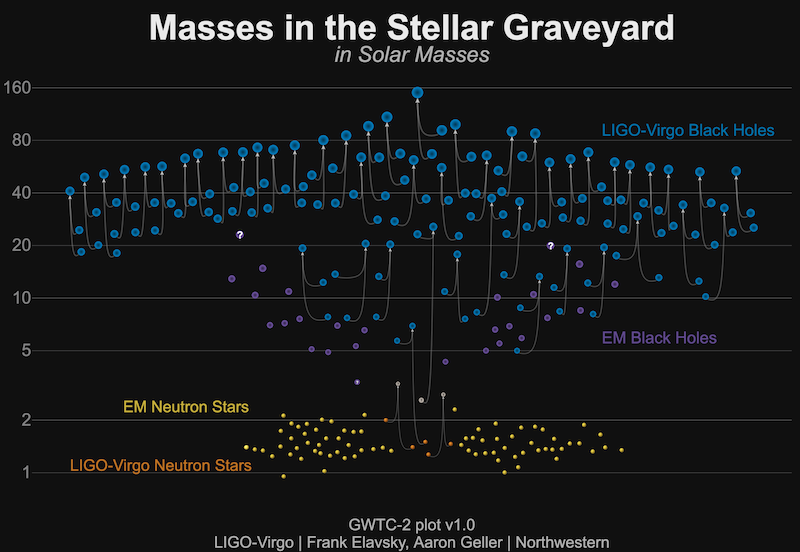On October 28, 2020, the LIGO Scientific Collaboration and the Virgo Collaboration announced the results of their searches for gravitational-waves from coalescing compact binaries during the first half of their third observing run (O3a), spanning 1 April 2019 to 1 October 2019. 39 events are reported here; when added to the 11 events in the first Gravitational-Wave Transient Catalog (GWTC-1), this brings the total number of reported LIGO/Virgo gravitational-wave detections to 50. Besides the paper discussing the new catalog, companion papers discuss population properties of the catalog, tests of general relativity, and a search for associated gamma-ray bursts.

Masses of detected LIGO/Virgo compact binaries. This plot shows the masses of all compact binaries detected by LIGO/Virgo, with black holes in blue and neutron stars in orange. Also shown are stellar mass black holes (purple) and neutron stars (yellow) discovered with electromagnetic observations. See also the interactive version of this figure. [Image credit: LIGO/VIrgo/Northwestern Univ./Frank Elavsky]
Publications & Documentation
- Publication: GWTC-2: Compact Binary Coalescences Observed by LIGO and Virgo During the First Half of the Third Observing Run – (submitted for publication). [pdf download from LIGO DCC] [arXiv version].
- LIGO Lab News Release.
- Science summary flyer [pdf flyer].
- Companion Papers:
- Population properties of compact objects from the second LIGO–Virgo Gravitational-Wave Transient Catalog – (submitted for publication). [pdf download from LIGO DCC] [arXiv version].
See also the associated science summary [pdf flyer]. - Tests of General Relativity with Binary Black Holes from the second LIGO–Virgo Gravitational-Wave Transient Catalog – (submitted for publication). [pdf download from LIGO DCC] [arXiv version].
See also the associated science summary [pdf flyer]. - Search for Gravitational Waves Associated with Gamma-Ray Bursts detected by Fermi and Swift during the LIGO-Virgo Run O3a – (submitted for publication). [pdf download from LIGO DCC] [arXiv version].
See also the associated science summary [pdf flyer].
- Population properties of compact objects from the second LIGO–Virgo Gravitational-Wave Transient Catalog – (submitted for publication). [pdf download from LIGO DCC] [arXiv version].
- Data release for O3a Catalog (Gravitational Wave Open Science Center/GWOSC).
- Factsheet for the O3a Catalog (pdf).
- Masses in the Stellar Graveyard (interactive plot)
- LIGO Compact Binary Interactive Catalogue.
- LIGO Compact Binary Interactive “Bubble” Plot.
- Interactive Gravitational Waveform Viewer.
- See the main ligo.org detection page for further resources.
LIGO/Virgo Binary-Black-Hole Orrery. A visualization of the merging black holes that LIGO and Virgo have observed so far. The video shows numerical-relativity calculations of the black holes’ horizons and the emitted gravitational waves, during the final few orbits of the black holes as they spiral inwards, merge and ring down. Each numerical-relativity calculation is consistent with one of the observations in the LIGO-Virgo catalog. This movie is inspired by the Kepler Orrery.
[Credits: Teresita Ramirez/Geoffrey Lovelace/SXS Collaboration/LIGO-Virgo Collaboration.]
LIGO-Virgo Compact Binary Coalescences Through O3a. This cartoon animation shows the orbits of the compact binaries (black hole and/or neutron star mergers) detected by the LIGO-Virgo Collaboration through the O3a observing run.
[Credits: Zoheyr Doctor/LIGO-Virgo Collaboration.]

